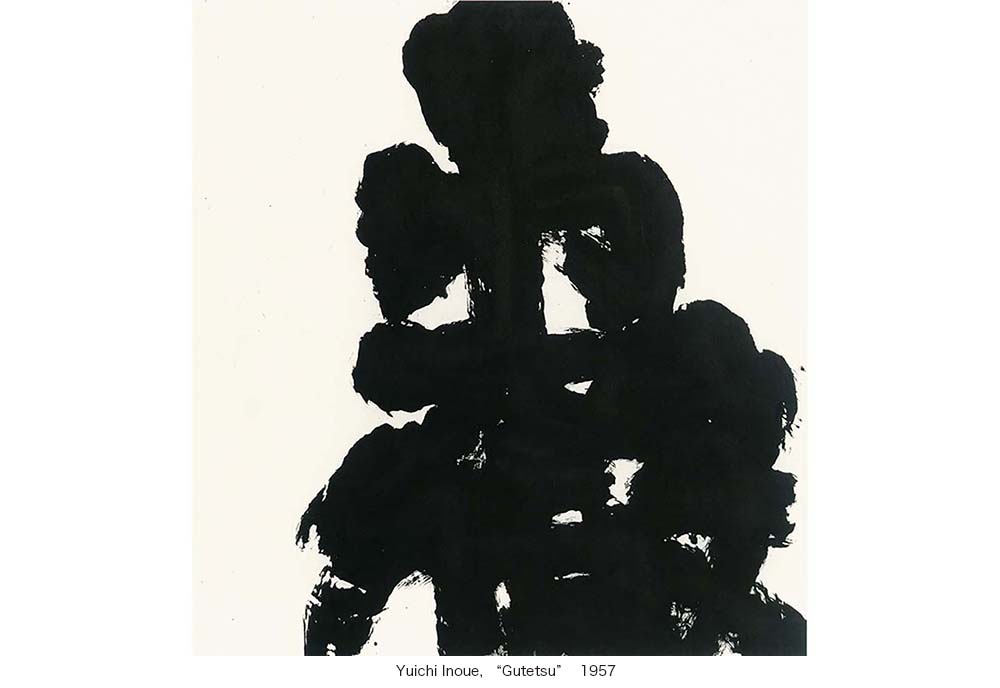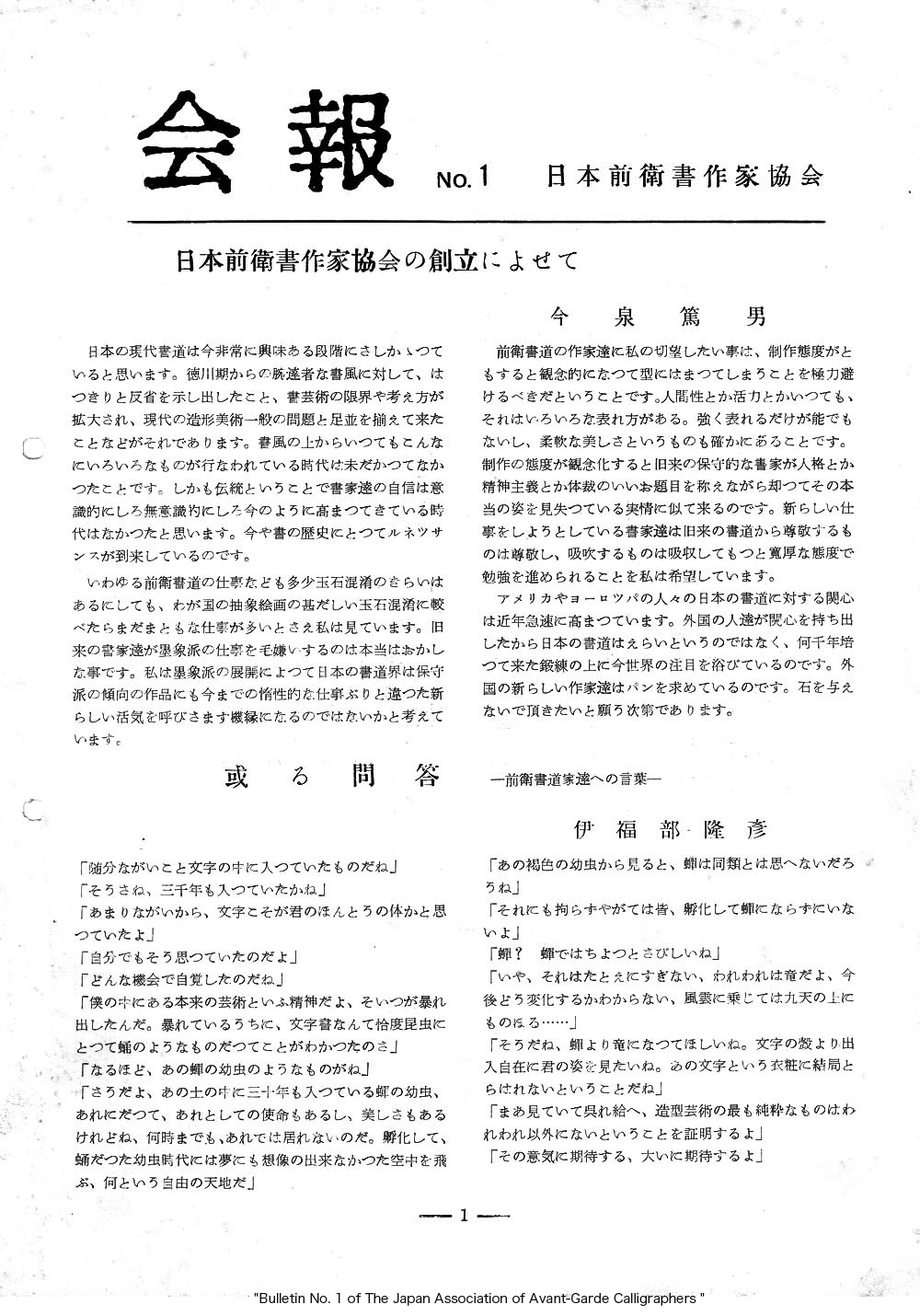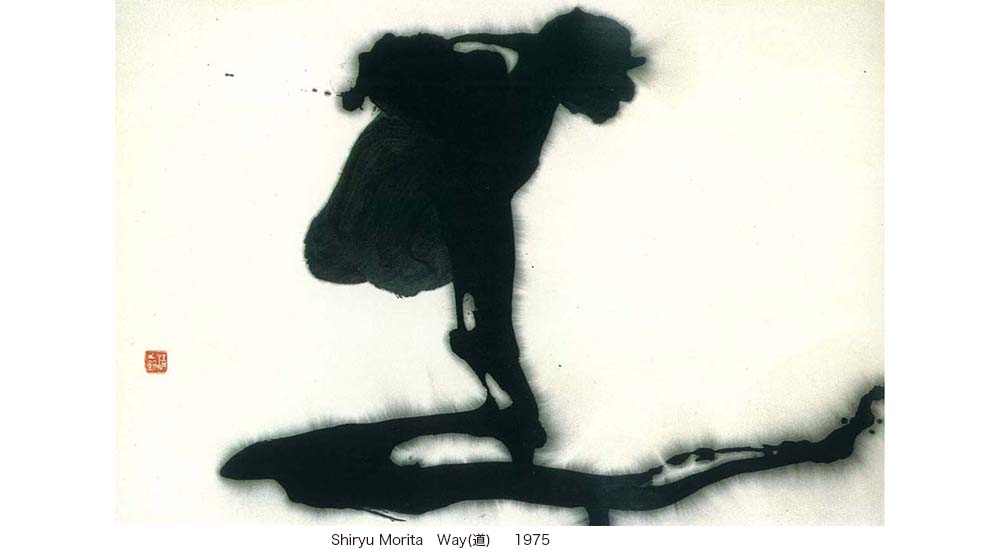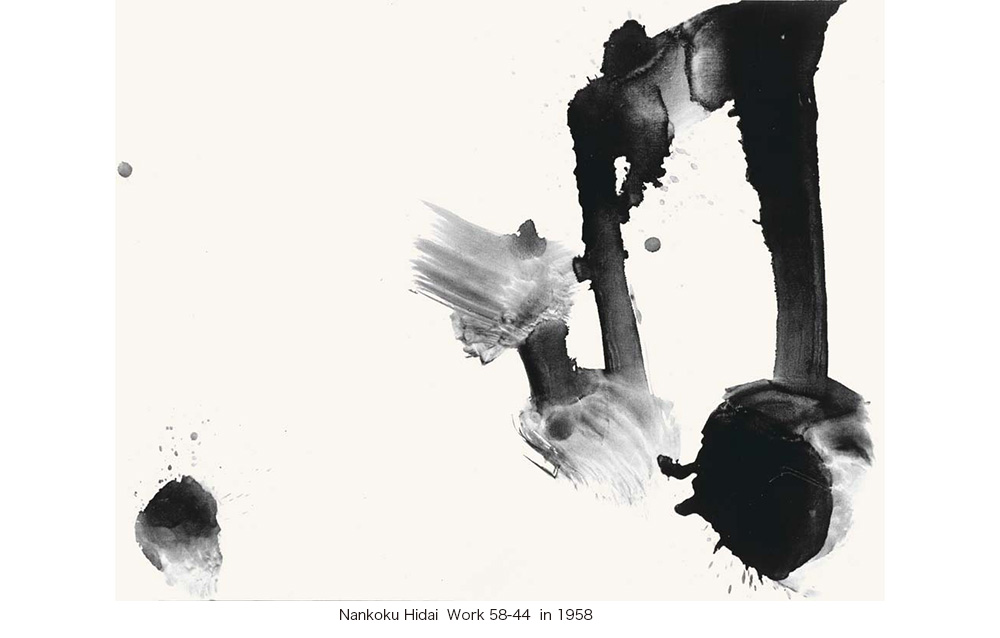Founding “The Japan Association of Avant-garde Calligraphers” in 1957 (2)
On August 10, 1957, about 70 calligraphers assembled at the temporary auditorium of the Tokyo Metropolitan Art Museum, and the general meeting for the establishment of the "Japan Association of Avant-Garde Calligraphers " was held with the announcement of Yuichi Inoue. From 2:00 p.m. the opening address by Tomin Hagiwara, the progress report by Nankoku Hidai, then chairman Sofu Okabe and Sofu Takeshi entered into the proceedings of the meeting. Under discussion on the rules and regulations, various opinions were issued, and enthusiastic deliberations continued for 4 hours on end in sweltering heat. At last, the rules and regulations were approved. “The Japan Association of Avant-Garde Calligraphers” was established with a report on the active plan by Yusui Nakajima and a closing address by Shiryu Morita.
“The Japan Association of Avant-Garde Calligraphers”
Rules and Regulations
1, Name
This association is called the Japan Association of Avant-Garde Calligraphers.
2, Purpose
This association cooperates for mutual communication and friendliness aiming at the development of calligraphic art with contemporary significance.
3. Head Office and Branches
The head office of this association is located in Tokyo and, if necessary, establishes a branch in the local area (prefectural units).
4, Business
In order to achieve its objectives, the Association will perform the following projects:
1. Matters related to contact
1. Matters related to international exchange
1. Matters that we have recognized as necessary
5, Association Member
The Association shall be composed of members and supporting members.
A member of the Association
Those who agree with the purpose of this Association and have paid a membership fee (annual amount 600 yen).
A supporting member
Those who agree with the purpose of the Association and help the Association.
6, Executive committee
A member of the committee
The term of committee shall be one year and 15 members shall be elected from among the members at the general meeting. However, the member of the committee may be reelected.
A committee manager
A person whom the committee commissions. The manager supervises the secretariat and is in charge of the affairs of the Association.
Auditing member
Two members shall be elected from among the members at the general meeting. The term of audit is one year and auditing member audits accounts of the Association.
7. Meeting
General Meeting
General meeting shall be held in August once a year. Extraordinary meetings shall be held at the request of the committee or at least one-third of the members as necessary, and the management of the meeting shall be decided.
Committee
It is composed of committee members and is in charge of the management of the Association.
8, Account
The management of the Association is based on membership fees, donations, and business profits.
The fiscal year is from August 1 to July 31 of the following year.
9. Withdrawal and expelling
Those who fall behind in their membership fees for more than one year are recognized as withdrawal, and if they act contrary to the purpose of the Association, they may be removed by the committee.
10. Amendments to the Rules and Regulations shall be decided by referring them to the General Meeting.
The following 15 members were elected at the time of establishment.
Yuichi Inoue, Suijyo Ikeda, Sokyu Ueda, Sesson Uno, Sofu Okabe, Gaboku Ogawa, Ryuho Kobayashi, Shunran Kagawa, Sofu Takeshi, Yoshimichi Sekiya, Oshu Chiyokura, Tomin Hagiwara, Yusui Nakajima, Nankoku Hidai, Shiryu Morita

Nankoku's comment on the founding of this "Japan Association of Avant-Garde Calligraphers" was carried in "Bulletin No. 1".
It can be said that it was announcement of a social ‘engagement’ corresponding to Nankoku's declaration "The ink form is social existence".
Comment of Nankoku Hidai
I am very happy that the long-expected “Association of Avant-Garde Calligraphers” has been born. Until now, avant-garde calligrapher belonged to some general organization or group, but each calligrapher's artistic activities were respectively individual. This is good in terms of producing each original work in the creative way, but it lacks mutual understanding, and there has been really disadvantage, especially when calligraphers try to start to social activities.
When I held a commemorative exhibition of my father this spring and asked 6 calligraphers related to my father to exhibit supportive works, I had naturally the characteristic to discuss with many persons concerned, because they belonged to each organization of avant-garde. People who seemed to have the exact opposite idea until then, if they talked together, could sympathize with each other, or even if they couldn't, they would understand and acknowledge each other's opposite positions. I found in turn that this was very valuable for each other to have a clear understanding of their individuality and intrinsic nature, and very useful to do a hard job.
In the conference on the establishment of the Japan Association of Avant-Garde Calligraphers, there was a completely opposite opinion concerning the matter, and it was not a little that it almost reached a deadlock. However, since the avant-garde digs up something new and unknown that each calligrapher has never had before, of course, there must be the opinion with very free width. It is natural that there is not typical in the way of thinking. In other words, if the avant-garde is faithful to his belief, he will try to hold fast to his standpoint and his way of thinking increasingly. I don't think that there is a single art organization where all avant-garde artists are united together in the same thought. In my opinion, this ‘Association’ is an extremely inclusive organization that should be acceptable to calligraphers with any idea, and should be an institution providing impartial cooperation for their common benefit.
There will probably be a conflict of different opinions in the future. However, I will be eager for its democratic development so that some ideas do not bring other opinions under control powerfully. The Association has just made a start, and the success or failure of its management will depend on its development in the future. Since we can expect many projects for the comprehensive development of avant-garde calligraphy, such as communication among members or with external world, support of the lives of artists, a plan for the exhibition, and the publication of works covering all members etc., I hope that everyone will work together for development of this Association in the future.

More than 10 years after the war, the avant-garde calligraphy expanded its activities and became widely recognized socially, and so avant-garde calligraphers began to make progress further based on their awareness and reflection. However, the reactions of the world of calligraphy and art to the avant-garde calligraphy (ink form) were severe. Their representative view is seen as follows.
In January 1957, Onoe Saishu, member of the Imperial Art Academy, died at the age of 80. In 1937, with Onoe Saishu, the world of calligraphy had recommended Tenrai Hidai as the first member of the Imperial Art Academy (Tenrai died two years later in 1939). There was a severe conflict about a member who was to succeed Onoe Saishu. Shunkai Bundo, member of Art Academy who remained only one in the calligraphy field, recommended his master’s son, Yasushi Nishikawa, but Shunkei Iijima and Sokyu Ueda belonging to the calligrapher’s council put forward Suiken Suzuki, contrary to Shunkai Bundo. (Suiken Suzuki was chosen as member of Art Academy in 1960, and Yasushi Nishikawa was chosen in 1969.)
Mr. Shunkai Bundo, a person concerned the turmoil of the world of calligraphy
"Ink Form can't be called calligraphy, but there's no complaint about avant-garde calligraphy."
From an article of newspaper that interviewed Shunkai Bundo in the midst of the turmoil
"I don't deal with the national matter such as the member of Art Academy by my small feeling that was said to recommend Mr. Nishikawa. Because I think that his jobs and his personality as calligrapher are splendid... I thought that Mr. Tsujimoto (Shiyu) was good after the death of Mr. Onoe, but he suddenly died at the end of last year. ・・・”
About Avant-Garde Calligraphy
"The avant-garde doesn't bother me at all, but some of them are puzzled. Because calligraphy is the art that the character(文字)is made beautiful to the end, if the ink form which disregards the character, does not insist on the calligraphy, I will not say the complaint. First, I do not have the right to restrain other people's freedom. So it seems considerably that I am a stubborn old man.“
In 1957
Avant-garde calligraphy closer to painting than calligraphy By Ryo Yanagi (Critic of Art)
I have a lively interest in the avant-garde calligraphy and sympathy with it, because it got rid of the stereotyped ideas and tried to break fresh ground in the world of the traditional calligraphy. But frankly speaking, it is not possible for me to cheer freely for the present state of the avant-garde calligraphy.
I feel that a new coined word of so-called Ink Form(墨象) tries to expand the category of calligraphy, though the word of Ink Form is weak in definition as it is and I seem that the works of Ink Form themselves cannot be distinguished between the picture and the character. That‘s the end of the matter, if Ink Form urges that its peculiarity is indistinguishable between the picture and the character.
There is a person who makes a problem whether the meaning can be read as character, but I am not blaming it in such a meaning. I do not think that it is possible to push on with the task in such a chimera as anything indefinite either bird or beast, because in calligraphy there is a methodology of calligraphy and in painting there is a methodology of painting, from the point of view in the pure formative art.
When I see the present state of avant-garde calligraphy, I have some doubt about it, because I feel that it is not like calligraphy but like picture in general. The reason why it seems to be a painting is that it has the inclination to set the plane and the point above the line as to the means of the representation, and so it sets ‘forme’ above ‘mouvement’. In other words, the form or shape is the main subject, and as a result it has fallen into a decorative one. Then, it is far from calligraphy and its spirit which bet all of the self-expression on the brush strokes. Although the calligraphers of the avant-garde should have started aiming at the escape from the form, on the contrary it seems that the avant-garde calligraphy goes for wool and comes home shorn now.
It is no use if avant-garde calligraphy separates from calligraphy and becomes picture, and if it is an abstract painting, it should take a way of proceeding of the abstract painting. So, the reflection is important. If it is painting, it should go with the plane and form, and if it is calligraphy, it should go with the line and the movement, and there is Art in the establishment of the methodology. There is no way if it forgets that.
Inside the avant-garde calligraphy, the statement was presented. It inquired what the avant-garde calligraphy was, from the sharp point of view by the original theory of calligraphy.
On September 30, 1957
" I Think about the Problem of Ink Form by Shiryu Morita " was appeared in the "Calligraphy Overview"
Shiryu Morita asks first what is the unique condition that calligraphy differs from other arts, especially painting.
It is not possible to distinguish it in the condition that on the one hand the painting dissolved the place of form of the external world, and the abstract and non-concrete painting was born, and on the other hand the calligraphy threw away the place of the character (文字), and the plane (abstract calligraphy) without the character was born. The constituents of the condition are "plane, color, and form", and then there is no distinction.
Then, the characteristic in the expression of calligraphy is clarified. The calligraphy has been approved as a place of the character. The characters (= symbols) in calligraphy have regulations on meaning, sound, and structure (horizontal stroke, vertical stroke, keep or bounce, writing order, etc.). Therefore, the constituents standing for the characteristics of calligraphy are
1. To use characters (letters) as its characteristic
Trying to write a certain character means that the self grasps itself in the character. It is to entrust oneself entirely to the word or the character. However, the self pursues itself grasped by the character, and it is beyond the self who was in one character with the meaning, sound, and form as its characteristics, and then it sinks into the bottom of the self which is the root which gave birth to the self. It returns to the completely free self which is not involved even in the character. And, it activates from the place to the expression. The self itself in the root becomes the character and moves actively. The self does not write the character, but it exceeds the characteristic of denial of the character, and yet the self becomes the character and it moves.
2. To express internal movements with denial of the character as its characteristic
Because calligraphy writes the character, it is an expression by time movement (there is a writing order). Moreover, it expresses directly the inside of the self. As long as a calligrapher writes the character as character, he is constrained by the character, and there can be no whole representation of his human beings. While writing the character, he exceeds the character, and then, for the first time the movement expressing calligraphy is immediately connected with his internal movement. The expression by the movement, namely, the form caught as the movement does not achieve without the characteristic of denial of the character.
3. To use black and white beyond all colors as its characteristic
An internal movement = a movement of life itself exceeds the color. The black and white in calligraphy are not black and white in many colors, but the black and white in calligraphy exist as the characteristic beyond all of colors.
4. To express infinite contents in one touch or one stroke of the movement of calligraphy as its characteristic
The movement of calligraphy is a direct flow of the inner movement, and it is complicated and various just as the inner state is complicated and various. The inside is caught in the movement between one touch from top to bottom or one stroke from left to right. The calligrapher fixes the movement through his hand or body, and through the brush on the paper. The power to hold down, to pull up, and to push out must be one as power to tighten into the inside as it is. A simple touch and simple stroke have infinite contents.
5. To be identical with the space of calligraphy and the inner life-world of the expressive subject as its characteristic
The movement of calligraphy is a whole representation of the inner life of the expressive subject. It is necessary not to see the movement in movement, but to see his life itself there, his inner world. The black and white are also completely one.
The white which was left is not the white that should be called the blank, but it is one life- world including the black. That is the space of calligraphy.
In this way, Shiryu Morita examines the position of Ink Form calligraphers based on the characteristics as expressive feature of calligraphy.
On September 30, 1957
Shiryu Morita " I Think about the Problems of Ink Form " "Calligraphy Overview"
(A) The works based on the dismantlement of the character were conducted among a part of the Keisei-kai --- It is self-evident that it is not already a character when the character was dismantled. In this case, the above-mentioned characteristic(1) in the expression of calligraphy, namely the consistency of the symbol is doubted, and I am dissatisfied with the fact that the denial of the character was made in such a superficial way. Even if the character is denied and dismantled, if the calligrapher adheres to the dismantlement, adheres to the form, and he adheres to the number of dots and strokes of a character, on the contrary he seems to be increasing adherence. For instance, to deny a tree is not to mean that a person cuts the tree and breaks the tree down, or that the tree is not a tree. On the contrary, it means that a person becomes human who is not bound by the tree. …Also, although these works are made by lines and dots, there is no consistent movement in them. … On paper, any line can be seen before or after, that is, any line seems to coexist. … It must be said that the works are quite different from the characteristic (2). …However, first of all the line can be seen and the black and white of the characteristic (3) are used in their works. So they have an aspect which passes in the calligraphy. Regarding the characteristic (4) and (5) ... in this case, I make no mention.
(B) Non-character works with overlapping thick ink and thin ink represented by Sofu Okabe in Sojin-sha -- They also lack (1) and (2) in the characteristics, and the movement also looks like the movement to make a form. ---From this point of view they seem to be quite different from the calligraphic characteristics. Although the black and white in (3) are used, they are based on the more multiple and gradual factor than the consistent single beginning of (4), so the space of calligraphy in (5) is also relative.
(C) The works with scattering dry ink like the style of Sofu Takeshi in Heigen-sha – They are not generally calligraphy in the sense that the character is not likely to be seen here. In terms of characteristics, (1) and (2) are very far apart from calligraphy, and there are doubts in (4). I can't help inclining my head about the width and depth of the calligraphic factor here.
(D) The works with flat-drawing line like the style of Shunran Kagawa in Keiko-kai - How about all but two points of being slightly a line (no consistency) and being the black and white in the condition and the characteristic seem to be anti-calligraphy?
(E) About Nankoku Hidai - of course, there are no characters. In the sense that his work has a positive and negative working (hold down and pull up, push out and tighten into)in one touch of characteristic (4), his line is extremely calligraphic, and therefore the space in (5) also has a calligraphic virtue. However, naturally the character in (1), and the consistency of the movement in (2) are thrown away. Of course, one line is the movement, but connecting before or after of each line cannot be seen from the paper. Although it is a really calligraphic line, I have a deeply feeling that the line is being used for the composition of the paper. From this point, I feel that it is received as a kind of painting. Even in the problem of the color in (3), the meaning of the color of the ground will need to be clarified.
(F) The works that are writing the character, but are difficult to read, such as the works by Sogen Eguchi, Yoshimichi Sekiya, Futoshi Tsuji, and others in Bokujin-sha. – They are is anyway calligraphic from (1) to (5) of characteristics. They deepen the consciousness of the meaning of writing the character, they are consistent in the character from the conception to the production, they have an beginning in the movement and an end. I can see they have not a little passion for calligraphy in (4),(5). …Because they are writing the character, but can not often read as a result, some people will say calligraphic work or other people will say non-calligraphy. As I'm focusing on ... (1) and (2), so I don't hesitate to call them calligraphy. The reason why they are not writing the character as character, is that they are trying to express each whole self by writing the character.
(G) Recent works by Yuichi Inoue, Suijyo Ikeda, and others -- They write the character, most of them can be read, and they have all the characteristics of calligraphy. They are correctly calligraphic works, not Ink Forms aside from the goodness or badness of the work.
…We can live the true self beyond the characters in calligraphy. That is the joy that we feel based on the connection with calligraphy, and how we can do so can be the so-called avant-garde. I think that the association of calligraphers who share together the joy which we feel from living in the character beyond the character, is just the true world of calligraphy. Isn't only the effort towards the awakening of the conservative calligraphers, a matter of great urgency by standing on the ground where the calligraphy is calligraphy, rather than by standing and moving blindly on the writing the character formally?

In 1957, at the 4th São Paulo Biennale exhibition, the artistry of calligraphy was paid attention, and a new category called "Ink Form" was introduced. Dr. Petrosa of Brazil, who was a curator of the exhibition, visited with contemporary art in Japan and inspected the exhibiting artists. Then Nankoku Hidai volunteered for the guide in the field of the calligraphy, and, as a result, two calligraphers, Yukei Tejima and Yuichi Inoue were chosen.
At the 5th SãoPaulo Biennale in 1959, Nankoku Hidai and Shiryu Morita were also selected for "Ink Form". "Ink Form" and "Avant-garde calligraphy" were proof that the artistic value in calligraphy was approved internationally.

The activities of “the Japan Association of Avant-Garde Calligraphers” lasted two years from its foundation (until1959).